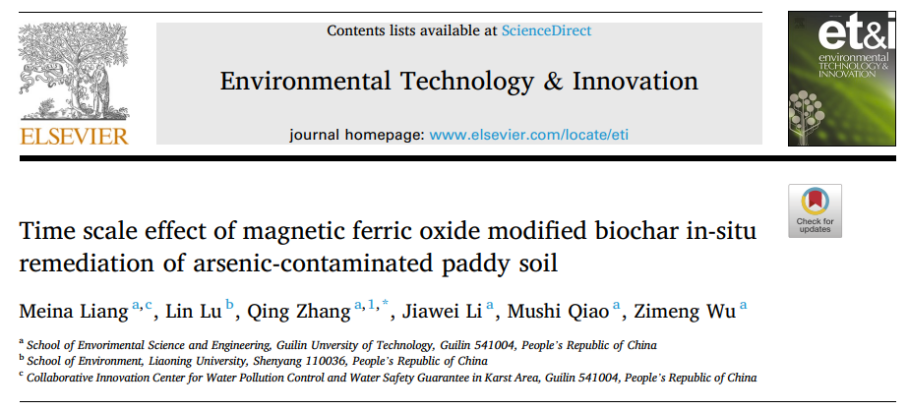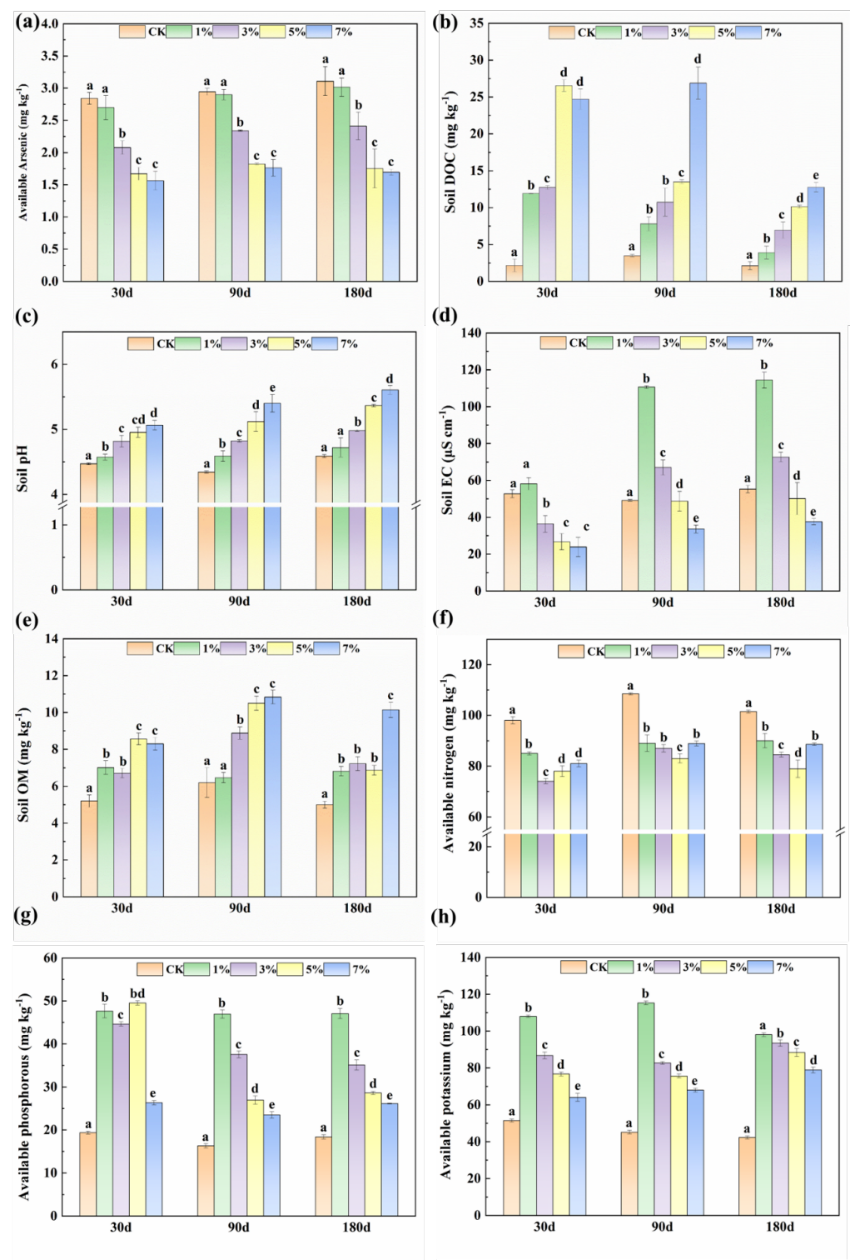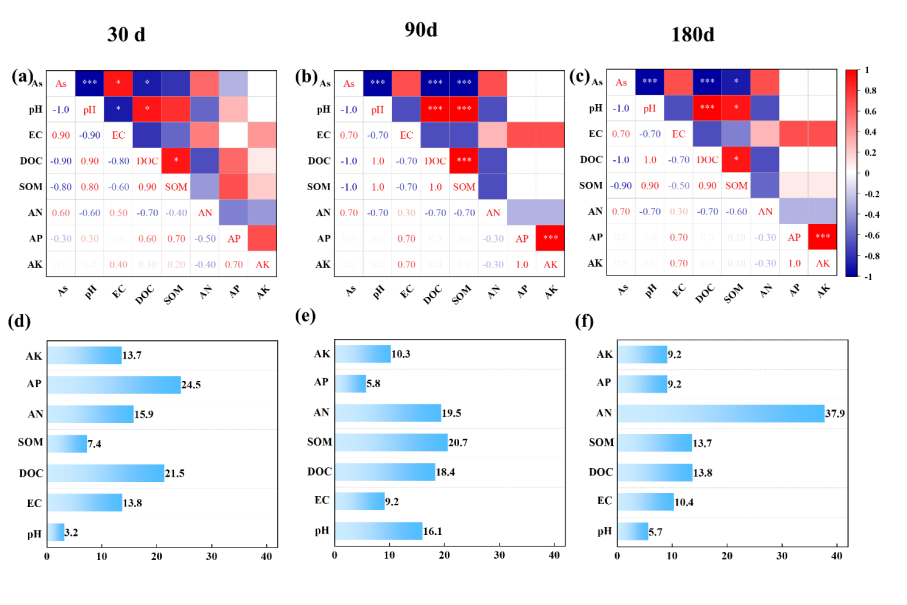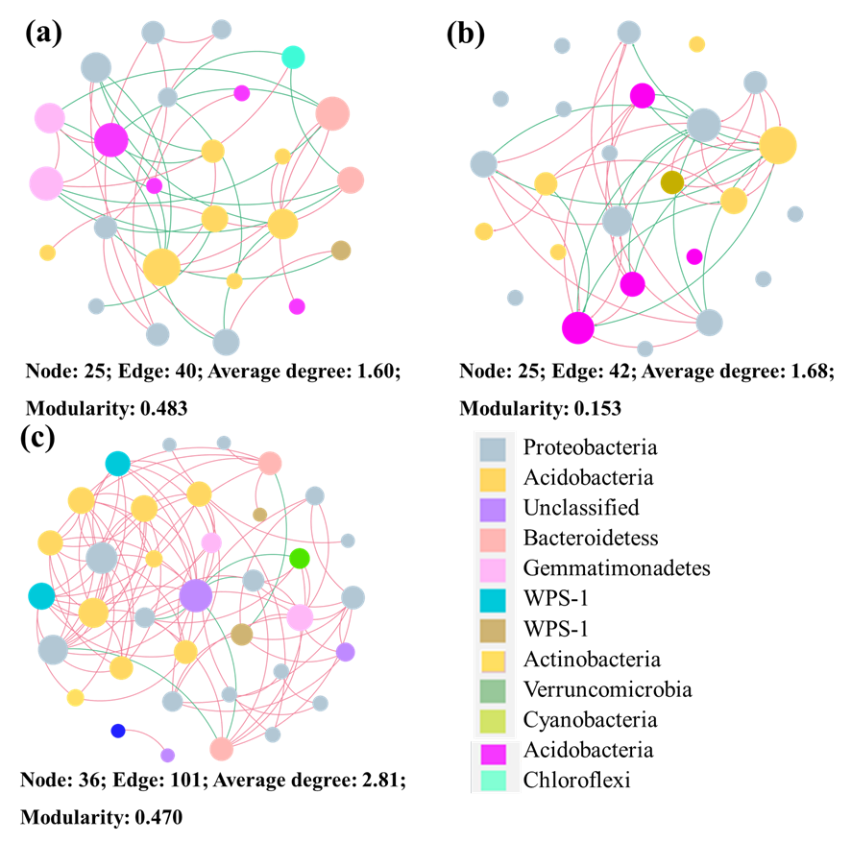
导读 | Introduction
砷是一种高毒性和致癌的类金属元素,对人类健康构成重大风险。调查公报显示,砷在稻田土壤中广泛分布,点位超标率约为2.7%。因此,修复砷污染土壤对于保障枯竭土壤资源的可持续发展,促进生态环境健康至关重要。利用生物炭降低污染物的生物可利用性,引起了全世界的广泛关注。然而,关于砷各组分、土壤性质和修复时间的系统性、全面性的研究有限。
Arsenic (As) is a hypertoxic and carcinogenic metalloid element that poses significant risks to human health and the environment. Approximately 2.7% of As exceeds China’s soil environmental quality limits. Therefore, remediating As-contaminated soil is crucial to safeguard the sustainable development of exhausted soil resources and promote eco-environmental health. The reduction of the bioavailability of pollutants using soil amendments (such as metal oxides or biochar) has attracted considerable worldwide attention. However, a limited systematic and comprehensive study on arsenic fractions, soil property, and remediation time has been conducted.
一、砷污染土壤理化性质的改变
| Changes in soil physicochemical properties
对照组土壤有效砷含量在第30、90和180天分别为2.84 ± 0.09、2.94 ± 0.09和3.10 ± 0.22 mg·kg-1。第30、90和180天,有效砷含量随MBC添加量的增加而显著降低。第30、90和180天,MBC的增加显著增加了土壤中SOM(图1e)。土壤孵育90 d后,SOM的峰值浓度为10.83 mg·kg-1。结果表明,添加MBC显著提高了土壤中SOM含量。不同剂量MBC对土壤必需营养元素N、P、K的影响如图1f、1g和1h所示。在孵育第30、90或180天,AP先迅速增加,然后逐渐趋于平缓。
In the CK group, the available arsenic contents in the soil were 2.84 ± 0.09, 2.94 ± 0.09, and 3.10 ± 0.22 mg·kg-1on days 30, 90, and 180, respectively. However, on days 30, 90, and 180, the concentration of available arsenic significantly decreased with increasing amounts of MBC. On days 30, 90, and 180, the addition of MBC dramatically increased the SOM in the soil, which was related to the dosage (Fig. 1e). After the soil sample was incubated for 90 d, the SOM reached a peak concentration of 10.83 mg·kg-1. The result showed that the addition of Fe-modified biochar significantly increased SOM in the soil. The soil essential nutrient elements N, P, and K with different dosage MBC are shown in Figs. 1f, 1g, and 1h. At incubation days 30, 90, or 180, AP rapidly increased at first and then gradually flattened.

图1 时间尺度上不同量的MBC对土壤理化性质的影响
Fig. 1 Changes over time (Day 30, 90 and 180) in soil physicochemical properties in soils amended without biochar (CK), and with magnetic biochar (MBC) at addition rates of 1%, 3%, 5%, and 7% of soil weight. The different BMC treatments followed by the same letter are not statistically significant at P < 0.05.
二、土壤性质的变化影响砷的生物有效性
| Changes in soil properties affect As bioavailability
对钝化过程中有效砷与土壤理化因子之间的关系进行Spearman相关性分析。如图2a-2c所示,相关系数达0.70,说明有效态砷与AN、EC呈显著正相关。此外,我们使用随机森林模型(RFM)评估了土壤理化因子对钝化过程中30、90和180天砷的有效性的影响,如图2d-2f所示,在整个钝化期,有效氮对有效砷的降低效果最为显著,重要性百分比在15.9%~ 37.9%之间。此外,SOM为第二大贡献因子。
An analysis was conducted to assess the relationship between available arsenic and soil physicochemical factors in the passive process (Figs. 2a-2c). The Spearman correlation coefficient reached 0.70, indicating a significant positive correlation between available arsenic and AN and EC. As shown in Figs. 2a–2c, the Spearman correlation coefficient was 0.70, indicating a significant positive correlation between available arsenic and AN and EC.
Furthermore, we used the Random Forest model (RFM) to assess the significance of soil physicochemical factors in influencing the availability of arsenic during the passivation process on days 30, 90, and 180, as illustrated in Figs. 2d–2f. Throughout the observation period, AN showed the highest significance in reducing available arsenic, with importance percentages ranging from 15.9% to 37.9%. Additionally, SOM emerged as the second most influential factor.

图2 有效砷与土壤理化性质Spearman相关分析和随机森林模型
Fig. 2 Spearman correlation analysis (a~c) and random forest model (d~f) with Available arsenic and soil phytochemistry physicochemical. (* P ≤ 0.05, ** P ≤ 0.01, *** P ≤ 0.001).
三、土壤微生物共生网络分析
| Co-occurrence network analysis
在不同时间尺度的土壤细菌共生网络图中,除了未分类节点,大部分的节点属于门变形菌门,占32%(30 d)、56%(90 d)和39%(180 d)。结果表明,MBC的施用增强了正相关关系,降低了菌群间可能的竞争。
随着MBC老化时间的延长,其pH值有缓慢升高的趋势(图1c),这可以促进细菌的生长,并增加MBC孔内的相互作用(图3c)。在第90天和180天观察到的细菌网络边缘数量最多,表明MBC提供了富含营养的基质,有利于形成更复杂的共生网络。
In the co-occurrence networks diagram of soil bacteria at different times, except for the unclassified nodes, most of the remaining nodes belong to the phylum Proteobacteria, accounting for 32% (30 d), 56% (90 d), and 39% (180 d). These results showed that the application of biochar enhanced the positive correlations and decreased possible competition.
As the MBC aging extended, its pH tended to increase slowly (Fig. 1c), which could promote bacteria growth and increase interaction within the MBC pores (Fig. 3c). The highest number of edges in the bacterial network observed on days 90 and 180 indicated that MBC provided a nutrient-rich substrate, favoring the formation of more complex co-occurrence networks.

图3 添加5% MBC后第30天、90天和180天细菌群落共生网络图
Fig. 3 The co-occurrence networks of bacterial community during Day 30 (a), 90 (b) and 180 (c) of add 5% MBC in soil.
总结 | Conclusions
本研究通过共沉淀法制备了一种名为MBC的钝化剂,并将其用于土壤中砷的钝化。土壤中添加MBC后,土壤pH、EC、DOC、SOM和AP均略有升高。Spearman相关分析和RFM分析表明,氮素对土壤中砷钝化过程的贡献最大,其次是SOM。结果表明,5% MBC固定砷效果最佳,有效态砷含量显著降低。此外,施用MBC降低了耐重金属细菌种类的丰富度。不同钝化时期土壤细菌共生网络的可视化显示,从第30天到第180天,土壤细菌共生网络的合作互惠性和复杂的相互作用增强。综上所述,MBC是一种有效的环境友好型钝化剂,可以减少土壤中砷的积累。
In the study, a passivating agent called MBC was prepared through coprecipitation and then used to passivate arsenic in soil. After MBC was added to the soil sample, all the soil pH, EC, DOC, SOM, and AP slightly increased. Spearman correlation and RFM analyses showed that AN had the highest contribution to the process of arsenic passivation in soil, followed by SOM. The results showed that 5% MBC exhibited optimal arsenic immobilization and significantly reduced the available arsenic. Additionally, the richness of heavy metal-tolerant bacterial species was reduced. The visualizations of soil bacterial co-occurrence networks over different passivate periods indicated more cooperative mutualism and complex interactions from day 30 to 180. In summary, MBC is an effective and environmentally friendly passivating agent that can reduce As accumulation in soil.